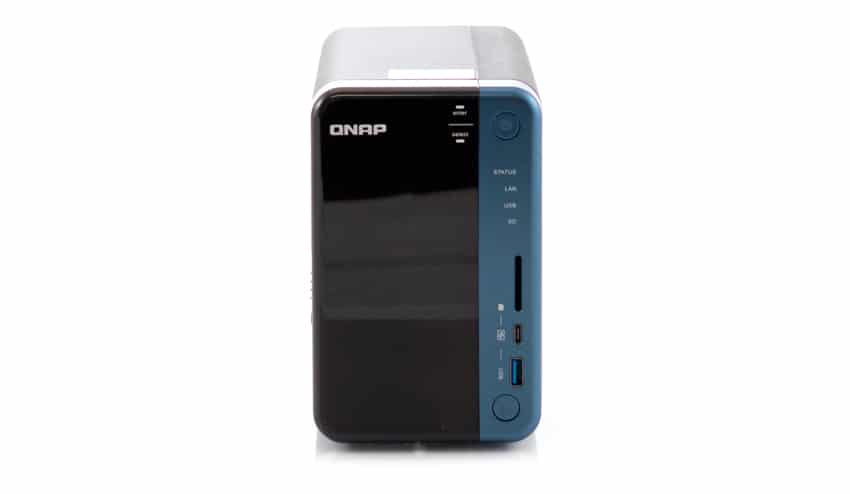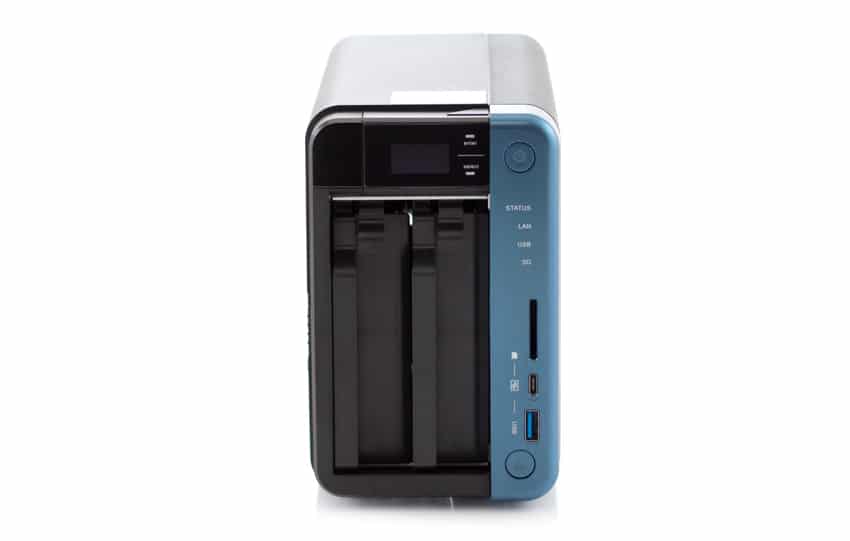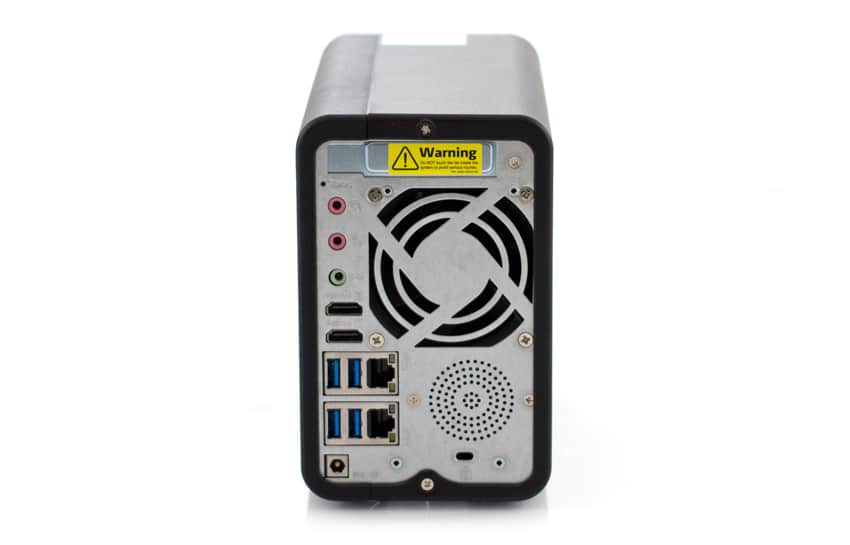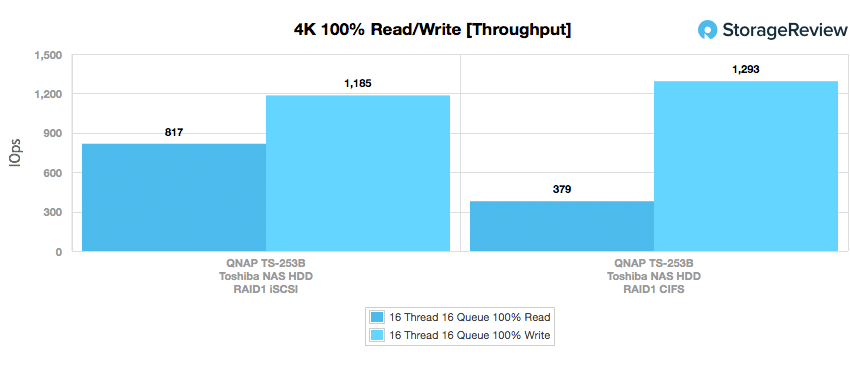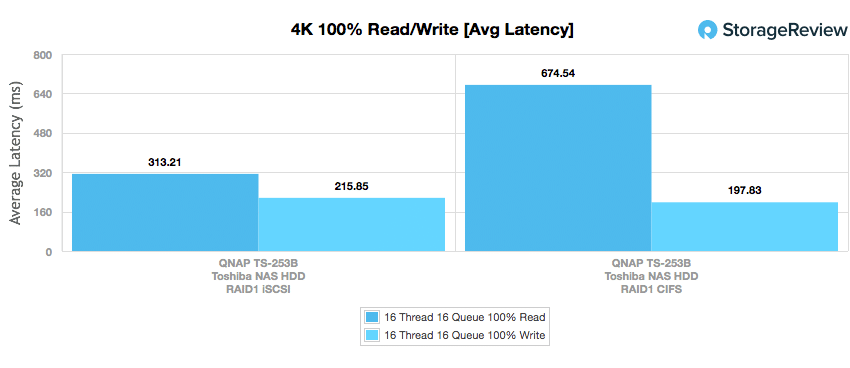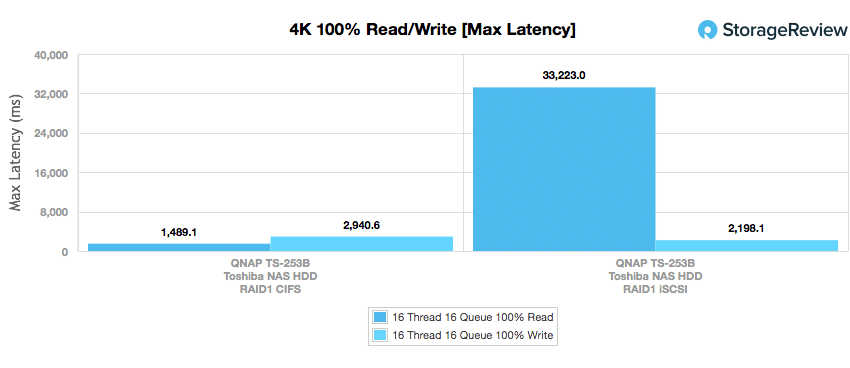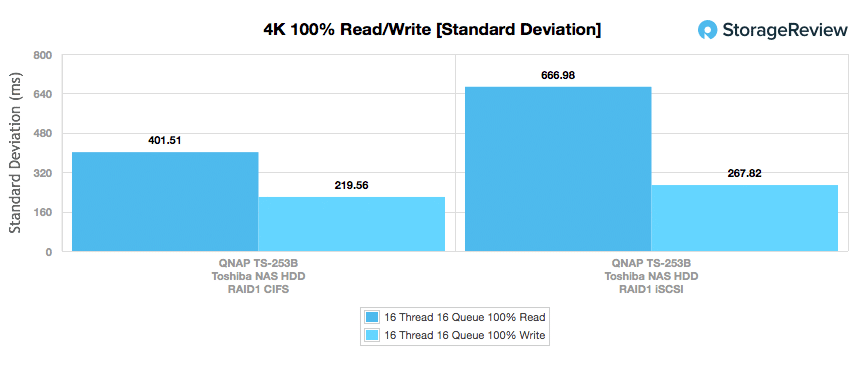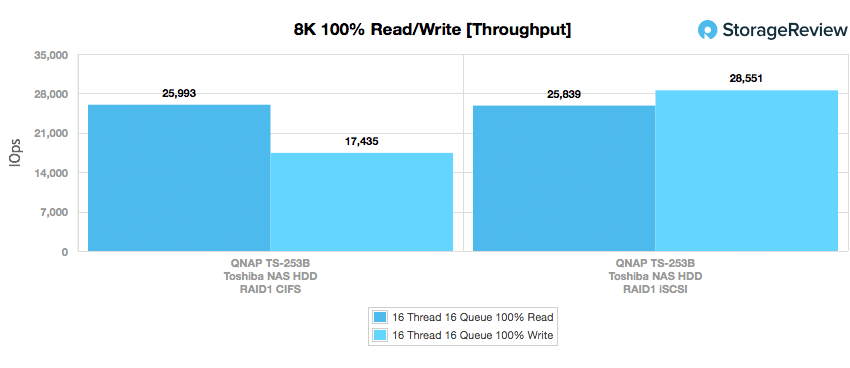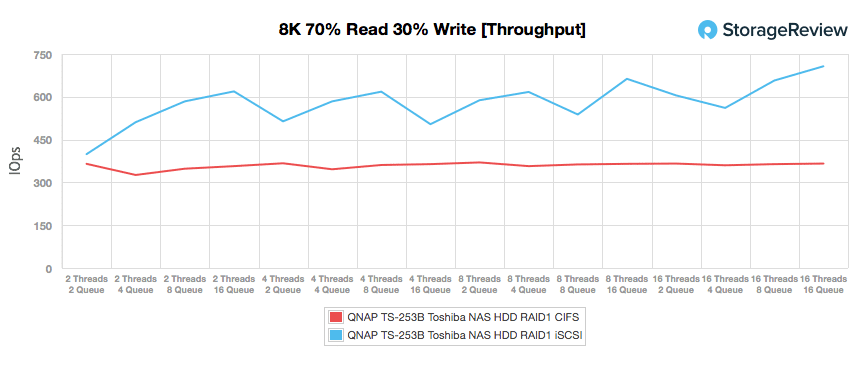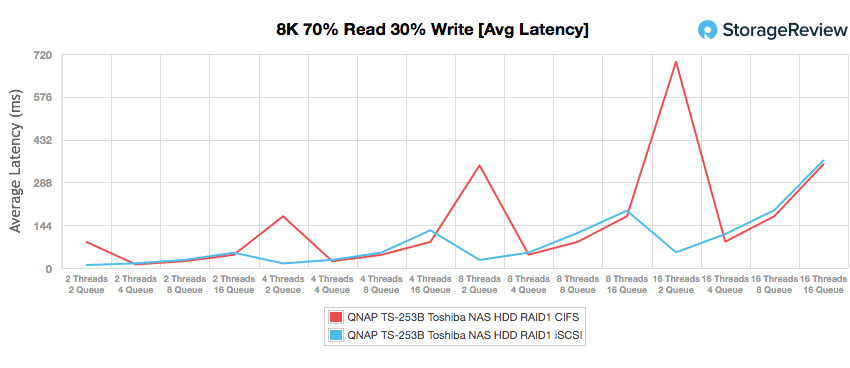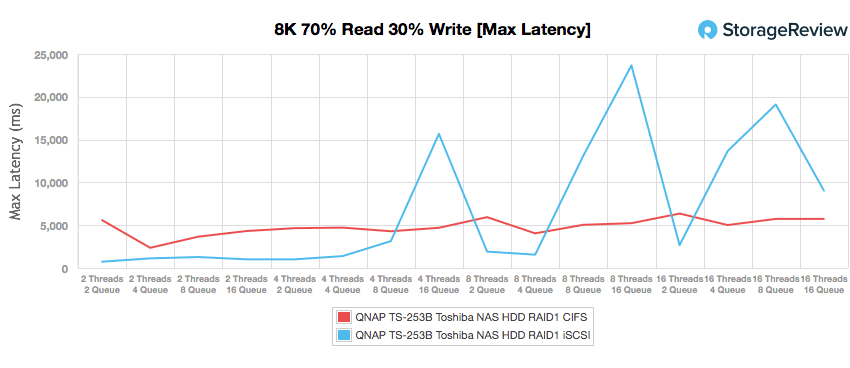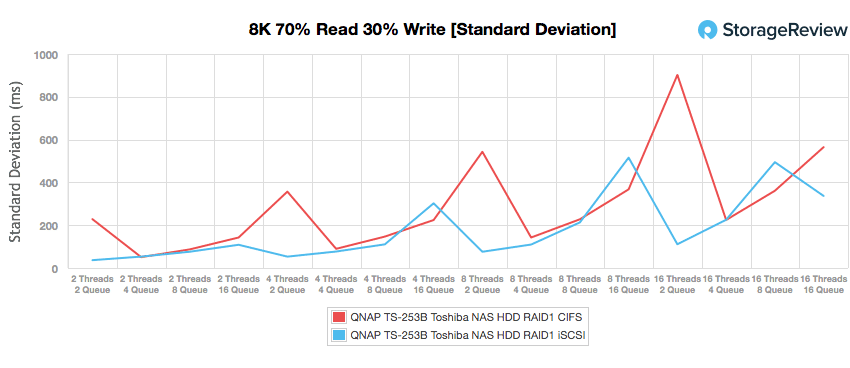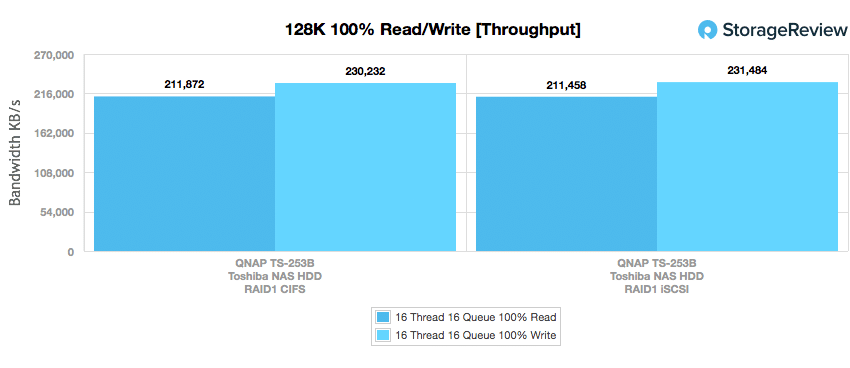
The QNAP TS-253B is the company’s latest 2-bay NAS solution to hit the market. Completely redesigned with a slick new build, the TS-253B features a PCIe port that can be equipped with a QNAP QM2 expansion card that supports dual M.2 SSDs and 10GbE connectivity, compatible wireless cards to turn the NAS into a wireless access point, and a USB 3.1 10Gbps card for faster backup transfer speeds to and from multiple external storage devices. The TS-253B also comes equipped with a USB Type-C QuickAccess port and a SD card slot, and supports 4K (30Hz) video playback with real-time transcoding.
Featuring a current-gen 14nm Intel Celeron quad-core 1.5GHz processor (with burst up to 2.3 GHz), up to 8GB of DDR3L RAM, dual Gigabit LAN ports and SATA 6Gb/s, QNAP quotes the TS-253B to deliver upwards of 225MB/s in read and write speeds. Performance doesn’t decrease when Intel AES-NI hardware-accelerated encryption is enabled says QNAP, indicating up to 225MB/s for both full NAS volumes and shared folders. This means performance can be maintained even while keeping data secure.
Backed by a 2-year warranty (though it can be upgraded to 5), the TS-253B can be picked up for as little as $530 for the 4GB RAM model.
QNAP TS-253B Specifications
- CPU: Intel Celeron J3455 quad-core 1.5 GHz, up to 2.3 GHz
- Encryption Acceleration: (AES-NI)
- Graphics: Intel HD Graphics 500
- System memory:
- 8GB DDR3L (2 x 4GB)
- 4GB DDR3L (2 x 2GB)
- Maximum Memory: 8GB
- Total Memory Slots: 2 x DDR3L SODIMM slots
- (For dual-DIMM configuration, you must use a pair of identical DDR3L modules.)
- Drives: Hot-swappable 2 x 3.5″/2.5″ SATA 6Gb/s HDD/SSD
- GbE LAN Port: 2 x RJ45 Gigabit LAN port
- 10GbE LAN Port: Optional 10 Gigabit LAN port via a PCIe expansion card
- USB 3.0 Port:5 x USB 3.0 Type-A ports
- USB QuickAccess: USB Type-C
- PCIe Slot: 1 PCIe 2.0 x2 slot
- HDMI Port: 2 x HDMI v1.4b, up to 3840 x 2160, 30 Hz
- Audio Input: 2 x 3.5mm dynamic microphone input jacks
- Audio Output speaker: 3.5mm line out jack
- Display: 0.96” monochrome OLED
- LED Indicators: Status/Power, LAN, USB, Drives, SD card, USB QuickAccess
- Buttons: Power, USB copy, Reset, Capacitive touch buttons (select, enter)
- Infrared Receiver, supplied with a QNAP RM-IR004 remote control (compatible with RM-IR002 remote control)
- SDXC Card Reader
- Kensington security slot
- Dimensions (HxWxD):
- 168 x 105 x 226 mm
- 6.61 x 4.13 x 8.90 inch
- Weight: 1.66 kg ( 3.66 lbs )
- Sound Level Operating low speed: 16.7 dB(A)
- Operating Temperature: 0 ~ 40˚C (32˚F ~ 104˚F)
- Relative Humidity: 5~95% RH non-condensing, wet bulb: 27˚C (80.6˚F)
- Power Consumption:
- HDD sleep: 13.07W
- Typical Operation: 20.42W
- Power Supply: 65W AC adapter, 100-240V
- Fan: 1 x 7 cm
- Package Contents: NAS, QIG, 2 x RJ45 ethernet cables, AC adapter, power cord, 2.5″ drive screw kit, RM-IR004 remote control
- Warranty:
Design and Build
The QNAP TS-253B sports a newly designed, sleek new look: a smooth plastic black enclosure with an OLED panel and two capacitive touch buttons and an aqua green panel where the connectivity resides. This device sits safely beside any workstation on its rubber feet pads.
On the right side of the TS-253B front panel is the power button, LEDs (status, drive and LAN), SD Card slot, USB QuickAccess port/LED (Type-C), USB 3.0 One Touch Copy port, and USB One Touch Copy button. The left side features the OLED panel, which can be navigated using the enter and select button.
The OLED panel allows you to restart and power off the TS-253B, configure or change the OLED panel password, view and configure network settings, and to see information on the system, physical disks, and volumes
The vast majority of back panel’s real estate is taken up by the 1 x 7 cm system fan. To the left is the PCIe slot (with cover), 2 HDMI ports, reset button, 4 USB 3.0 ports, 3.5 mm speaker and microphone jacks, 2 Gigabit RJ45 Ethernet ports, a Kensington security slot and a Power input port.
Enterprise Synthetic Workload Analysis
Our enterprise hard drive benchmark process preconditions each drive into steady-state with the same workload the device will be tested with under a heavy load of 16 threads with an outstanding queue of 16 per thread, and then tested in set intervals in multiple thread/queue depth profiles to show performance under light and heavy usage. Since hard drives reach their rated performance level very quickly, we only graph out the main sections of each test.
Preconditioning and Primary Steady-State Tests:
- Throughput (Read+Write IOPS Aggregate)
- Average Latency (Read+Write Latency Averaged Together)
- Max Latency (Peak Read or Write Latency)
- Latency Standard Deviation (Read+Write Standard Deviation Averaged Together)
Our Enterprise Synthetic Workload Analysis includes four profiles based on real-world tasks. These profiles have been developed to make it easier to compare to our past benchmarks as well as widely-published values such as max 4k read and write speed and 8k 70/30, which is commonly used for enterprise drives.
- 4k
- 100% Read or 100% Write
- 100% 4k
- 8k 70/30
- 70% Read, 30% Write
- 100% 8k
- 8k (Sequential)
- 100% Read or 100% Write
- 100% 8k
- 128k (Sequential)
- 100% Read or 100% Write
- 100% 128k
In the first of our enterprise workloads, we measured a long sample of random 4k performance with 100% write and 100% read activity. Here, the QNAP TS-253B posted 1,293 IOPS write and 379 IOPS read in CIFS. Though iSCSI connectivity had slightly lower write performance, it had significantly higher read activity with 817 IOPS.
The results of the average latency showed similar results, with 313.21ms read and 215.85ms write when configured in iSCSI and 674.54ms read and 197.83ms write when configured in CIFS.
In the max latency benchmark, the QNAP TS-253B recorded its best write performance in our iSCSI configuration with 2,198.1ms and its best read performance during CIFS with 1489.1ms. Read latency was significantly higher in iSCSI, which posted 33,223.0ms.
When looking at standard deviation of random 4k performance, the TS-253B recorded 401.51ms read and 219.56ms write in CIFS, while reaching 666.98ms read and 267.82ms write under iSCSI.
Our next benchmark measures 100% 8k sequential throughput with a 16T/16Q load in 100% read and 100% write operations.Though the TS-253B showed its best write performance by far under iSCSI with 28,551 IOPS (vs. 17,435 under CIFS), the QNAP NAS had slightly better read numbers when using CIFS (25,993 IOPS vs. 25,839 IOPS).
Compared to the fixed 16 thread, 16 queue max workload we performed in the 100% 4k write test, our mixed workload profiles scale the performance across a wide range of thread/queue combinations. In these tests, we span workload intensity from 2 threads and 2 queue up to 16 threads and 16 queue. When looking at throughput, and the QNAP TS-253B iSCSI lead the way with a range of 399 IOPS to 707 IOPS. CIFS had a range of just 365 IOPS to 366 IOPS.
In average latency, iSCSI should great initial performance at just 10ms; however, it fell behind in higher queue depths with 361.61ms. Our CIFS configuration posted a range of 87.46ms to 349.0ms.
Results told a similar story when looking at maximum latency, as QNAP TS-253B showed its best burst performance when configured in iSCSI with 736.97ms, but fell well short of our CIFS configuration with 9,031.76ms. Our CIFS configuration showed 5,593ms at 2 Threads/2 Queue and 5,737.49ms at 16 Threads/16 Queue.
In terms of standard deviation, the QNAP NAS recorded 36.68ms through 336.75ms under iSCSI and 228.44ms through 564.83ms under CIFS.
Our last test in our small NAS Synthetic Workload testing is the 128k test, which is a large block sequential test that shows the highest sequential transfer speed. When looking at the 128k performance of 100% write and 100% read activity, the QNAP TS-253B showed very close results for CIFS and iSCSI, recording 230,232 IOPS write/211,872 IOPS read and 231,484 IOPS write/211,458 IOPS read, respectively.
Conclusion
The TS-253B is yet another solid release by QNAP that brings the company’s comprehensive NAS features to the Linux open-source platform. With a redesigned exterior, the NAS comes with a current-gen 14nm Intel Celeron quad-core 1.5GHz processor, up to 8GB of DDR3L RAM, and dual Gigabit LAN ports. According to QNAP, the TS-253B is able to hit 255MB/s even with Intel AES-NI hardware-accelerated encryption enabled. The new NAS also has a PCIe slot for either adding a QM2 dual M.2 SSD card or 10GbE connectivity.
The TS-253B is also equipped with entertainment-centric features, such as a real-time and offline 4k transcoding, two HDMI ports, and two 13.5 mm speaker and microphone jacks. The new QNAP NAS also supports the one-way sync data to cloud storage through RTRR, Rsync, FTP, SMB protocol, or two-way sync your NAS with remote NAS/cloud services such as Amazon S3, Microsoft Azure and Dropbox.
The TS-253B performed well for a 2-bay NAS. In terms of throughput, we measured its best write 4k performance in CIFS with 1,293 IOPS, while iSCSI connectivity boasted its best read performance with 817 IOPS. Looking at 8k sequential throughput showed its best write performance by far under iSCSI with 28,551 IOPS, while read numbers were slightly better under CIFS with 25,993 IOPS. During our 128k benchmark, the QNAP TS-253B showed solid results in both CIFS and iSCSI, recording 230,232 IOPS write/211,872 IOPS read and 231,484 IOPS write/211,458 IOPS read, respectively.
The Bottom Line
The TS-253B provides enough performance for most small businesses with a redesigned look making it look at home in a modern office.
Sign up for the StorageReview newsletter

